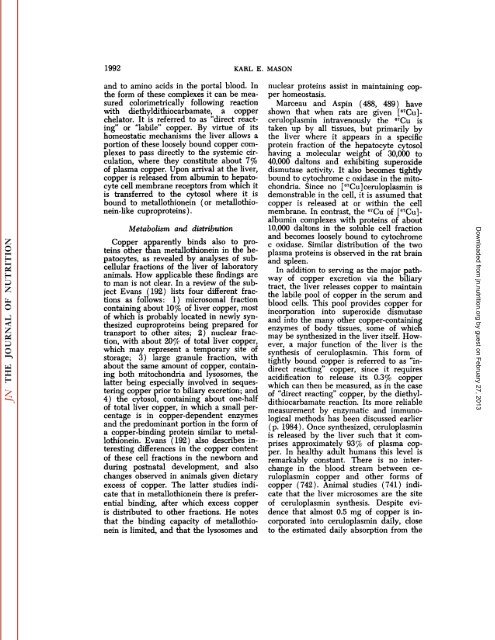conspectus of researchon copper metabolism and requirements
conspectus of researchon copper metabolism and requirements
conspectus of researchon copper metabolism and requirements
Create successful ePaper yourself
Turn your PDF publications into a flip-book with our unique Google optimized e-Paper software.
1992 KARL E. MASON<br />
<strong>and</strong> to amino acids in the portal blood. In<br />
the form <strong>of</strong> these complexes it can be mea<br />
sured colorimetrically following reaction<br />
with diethyldithiocarbamate, a <strong>copper</strong><br />
chelator. It is referred to as "direct react<br />
ing" or "labile" <strong>copper</strong>. By virtue <strong>of</strong> its<br />
homeostatic mechanisms the liver allows a<br />
portion <strong>of</strong> these loosely bound <strong>copper</strong> com<br />
plexes to pass directly to the systemic cir<br />
culation, where they constitute about 1%<br />
<strong>of</strong> plasma <strong>copper</strong>. Upon arrival at the liver,<br />
<strong>copper</strong> is released from albumin to hepatocyte<br />
cell membrane receptors from which it<br />
is transferred to the cytosol where it is<br />
bound to metallothionein (or metallothionein-like<br />
cuproproteins ).<br />
Metabolism <strong>and</strong> distribution<br />
Copper apparently binds also to pro<br />
teins other than metallothionein in the hepatocytes,<br />
as revealed by analyses <strong>of</strong> subcellular<br />
fractions <strong>of</strong> the liver <strong>of</strong> laboratory<br />
animals. How applicable these findings are<br />
to man is not clear. In a review <strong>of</strong> the sub<br />
ject Evans (192) lists four different frac<br />
tions as follows: 1) microsomal fraction<br />
containing about 10% <strong>of</strong> liver <strong>copper</strong>, most<br />
<strong>of</strong> which is probably located in newly syn<br />
thesized cuproproteins being prepared for<br />
transport to other sites; 2) nuclear frac<br />
tion, with about 20c/( <strong>of</strong> total liver <strong>copper</strong>,<br />
which may represent a temporary site <strong>of</strong><br />
storage; 3) large granule fraction, with<br />
about the same amount <strong>of</strong> <strong>copper</strong>, contain<br />
ing both mitochondria <strong>and</strong> lysosomes, the<br />
latter being especially involved in seques<br />
tering <strong>copper</strong> prior to biliary excretion; <strong>and</strong><br />
4) the cytosol, containing about one-half<br />
<strong>of</strong> total liver <strong>copper</strong>, in which a small per<br />
centage is in <strong>copper</strong>-dependent enzymes<br />
<strong>and</strong> the predominant portion in the form <strong>of</strong><br />
a <strong>copper</strong>-binding protein similar to metal<br />
lothionein. Evans (192) also describes in<br />
teresting differences in the <strong>copper</strong> content<br />
<strong>of</strong> these cell fractions in the newborn <strong>and</strong><br />
during postnatal development, <strong>and</strong> also<br />
changes observed in animals given dietary<br />
excess <strong>of</strong> <strong>copper</strong>. The latter studies indi<br />
cate that in metallothionein there is prefer<br />
ential binding, after which excess <strong>copper</strong><br />
is distributed to other fractions. He notes<br />
that the binding capacity <strong>of</strong> metallothio<br />
nein is limited, <strong>and</strong> that the lysosomes <strong>and</strong><br />
nuclear proteins assist in maintaining cop<br />
per homeostasis.<br />
Marceau <strong>and</strong> Aspin (488, 489) have<br />
shown that when rats are given [07Cu]ceruloplasmin<br />
intravenously the 67Cu is<br />
taken up by all tissues, but primarily by<br />
the liver where it appears in a specific<br />
protein fraction <strong>of</strong> the hepatocyte cytosol<br />
having a molecular weight <strong>of</strong> 30,000 to<br />
40,000 daltons <strong>and</strong> exhibiting Superoxide<br />
dismutase activity. It also becomes tightly<br />
bound to cytochrome c oxidase in the mito<br />
chondria. Since no [G7Cu]ceruloplasmin is<br />
demonstrable in the cell, it is assumed that<br />
<strong>copper</strong> is released at or within the cell<br />
membrane. In contrast, the G7Cu<strong>of</strong> [n7Cu]albumin<br />
complexes with proteins <strong>of</strong> about<br />
10,000 daltons in the soluble cell fraction<br />
<strong>and</strong> becomes loosely bound to cytochrome<br />
c oxidase. Similar distribution <strong>of</strong> the two<br />
plasma proteins is observed in the rat brain<br />
<strong>and</strong> spleen.<br />
In addition to serving as the major path<br />
way <strong>of</strong> <strong>copper</strong> excretion via the biliary<br />
tract, the liver releases <strong>copper</strong> to maintain<br />
the labile pool <strong>of</strong> <strong>copper</strong> in the serum <strong>and</strong><br />
blood cells. This pool provides <strong>copper</strong> for<br />
incorporation into Superoxide dismutase<br />
<strong>and</strong> into the many other <strong>copper</strong>-containing<br />
enzymes <strong>of</strong> body tissues, some <strong>of</strong> which<br />
may be synthesized in the liver itself. How<br />
ever, a major function <strong>of</strong> the liver is the<br />
synthesis <strong>of</strong> ceruloplasmin. This form <strong>of</strong><br />
tightly bound <strong>copper</strong> is referred to as "in<br />
direct reacting" <strong>copper</strong>, since it requires<br />
acidification to release its 0.3% <strong>copper</strong><br />
which can then be measured, as in the case<br />
<strong>of</strong> "direct reacting" <strong>copper</strong>, by the diethyl<br />
dithiocarbamate reaction. Its more reliable<br />
measurement by enzymatic <strong>and</strong> immunological<br />
methods has been discussed earlier<br />
(p. 1984). Once synthesized, ceruloplasmin<br />
is released by the liver such that it com<br />
prises approximately 93r/f <strong>of</strong> plasma cop<br />
per. In healthy adult humans this level is<br />
remarkably constant. There is no inter<br />
change in the blood stream between ce<br />
ruloplasmin <strong>copper</strong> <strong>and</strong> other forms <strong>of</strong><br />
<strong>copper</strong> (742). Animal studies (741) indi<br />
cate that the liver microsomes are the site<br />
<strong>of</strong> ceruloplasmin synthesis. Despite evi<br />
dence that almost 0.5 mg <strong>of</strong> <strong>copper</strong> is in<br />
corporated into ceruloplasmin daily, close<br />
to the estimated daily absorption from the<br />
Downloaded from<br />
jn.nutrition.org<br />
by guest on February 27, 2013
















